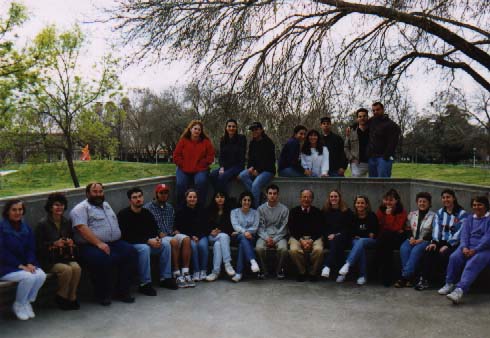
By Matthew Maroot
Staff Writer
For three consecutive weekends beginning Friday, February 26, 1999, 35 Fresno State students undertook an intensive study of one of the most cherished aspects of the Armenian culture, Armenian miniature painting.
In this three-unit-course titled, Armenian Studies 121: Armenian Miniature Painting, taught by Dr. Dickran Kouymjian, Haig and Isabel Berberian Professor of Armenian Studies, students had the opportunity to gain an in-depth knowledge of Armenian painting through the presentation of hundreds of color slide illustrations of miniature paintings, also known as illuminated manuscripts.
Many students took advantage of this weekend course to gain a greater appreciation of Armenian art. In fact, enrollment far surpassed that of previous offerings of this specialized upper-division course. “I was pleased but also surprised. Why all of the sudden 35 students in an upper-division specialized three-credit course in medieval Armenian miniature painting?” asked Dr. Kouymjian.
While the answer to that question may not have been obvious, student appreciation for the study of Armenian painting certainly was. Through quick, yet thorough explanation, Dr. Kouymjian covered the development of Armenian miniature painting from its beginnings in the sixth century up through its Golden Age and beyond the eighteenth century. In addition, he also made numerous comparisons to other contemporary works along the way including examples in Byzantine, Syrian, Islamic and Western art.
Dr. Kouymjian’s ability to explain the topic of Armenian art to students with relatively little background in art history was remarkable. By the end of the three-week session, students not only gained a greater understanding of Armenian art, but a working knowledge of the study of art history as well.
In addition to studying the iconographical elements of various illuminated manuscripts, students also learned how a manuscript is copied and bound and how its contents are arranged.
Dr. Kouymjian also spoke extensively about the major repositories of Armenian manuscripts throughout the world including the Matenadaran in Erevan, and other centers such as the Patriarchate of Jerusalem and the Mekhitarist Brotherhood in Venice. “This information will prove valuable when they [students] visit the great museums of the world and come before medieval Italian and Renaissance paintings, whose subject matter is predominantly Christian,” Dr. Kouymjian said.
With Armenian Studies 20: The Arts of Armenia, the prerequisite course to Armenian Studies 121, becoming part of the Fresno State revised General Education Program, interest in Armenian art will undoubtedly grow. It may also influence what Dr. Kouymjian describes as a growing interest in this area of study.
“No one taught Armenian art in this country when I began doing it upon my arrival from Paris in 1977. Now we have an endowed chair in Armenian art at Tufts University headed by Professor Lucy Der Manuelian, and for more than a decade Professor Thomas Mathews has been teaching Armenian iconography at the Art Institute of New York University and has seen some brilliant younger scholars through their Ph.D. in art history with an emphasis on Armenian art,” Dr. Kouymjian said.
When I started it was much neglected, now there is a greater interest in it and publications have been flowing from scholars in Europe and the United States as well as from Erevan. The important thing is to bring an awareness of an incredible cultural legacy to students who simply did not know of its very existence” Dr. Kouymjian said.
Dr. Kouymjian recognizes the complexities in teaching a subject about which most students have very little prior knowledge. However, he takes that challenge in stride. “Though they could probably recognize an eleventh century Armenian primitive or a painting by T’oros Roslin [a famous thirteenth century Armenian painter] pretty easily, the irony is that most students have never had another art history course and probably couldn’t tell a Duccio from a Rubens. Yet, they can identify the subjects these latter painters used in their works,” Dr. Kouymjian said.
While students who do not pursue any further study in the area of Armenian art may not remember all of the manuscripts they viewed over this three-weekend course, Dr. Kouymjian is confident that they will remember many other valuable lessons.
“In short, through Armenian miniature painting, students have learned the language and content of all Christian painting,” Dr. Kouymjian said. “What is certain is that they will know forever that Armenians had a rich and complex tradition of manuscript painting, that such information is available through monographic studies and exhibition catalogues and that Armenian art is extremely important to the early history of Christian art.”
 Hye Sharzhoom Armenian Action
Hye Sharzhoom Armenian Action